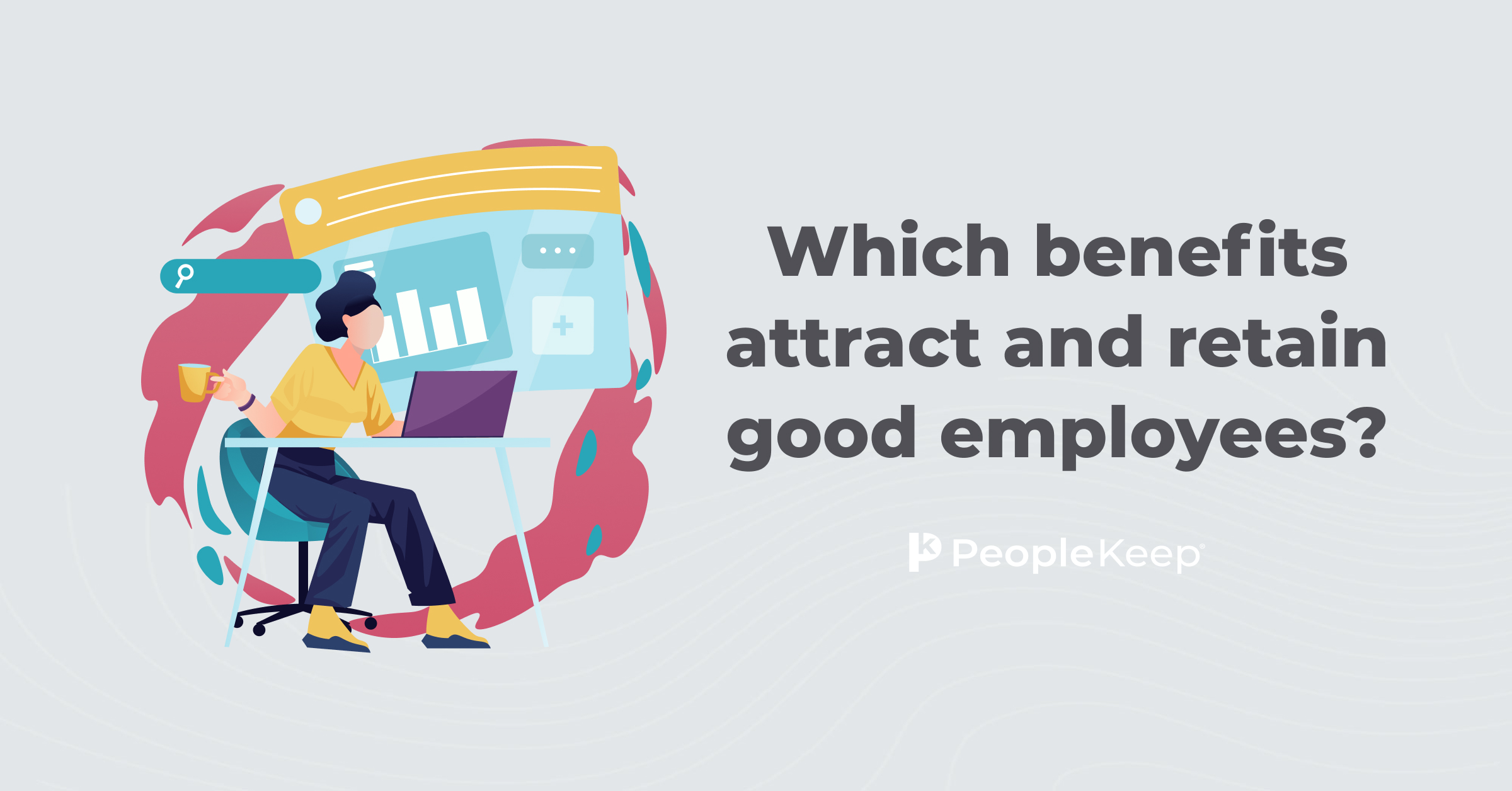Unique employee benefits ideas for all budgets
By Chase Charaba on November 6, 2025 at 7:00 AM
Providing your workforce with a comprehensive benefits package is essential for employee retention and recruitment. Small organizations may have to go the extra mile to hire the top talent they seek.
Employee benefits and perks are the best ways to support your current employees while making your organization stand out to job candidates.
With so many employee benefits options to choose from, how do you know which ones are best for your organization?
In this article, we'll explore a variety of unique employee benefits ideas tailored for all budget types. We'll also share practical tips for implementing them at your organization.
In this blog post, you'll learn:
- How employee benefits can help your organization thrive.
- The employee benefits that matter most to employees.
- How you can offer an affordable health benefit using an HRA.
Why should employers offer employee perks?
Before we share our list of unique employee perks ideas, it's crucial to understand why you should offer employee benefits.
Benefits reduce employee turnover
Compensation and employee benefits packages are among the most critical factors for reducing employee turnover. According to MetLife1, 73% of employees would stay with their current employer longer if they received more benefits.
Offering employee perks that your current employees want encourages them to stay with your organization. If your benefits package is better than what your competitors provide, your employees will be less interested in looking for other opportunities.
Improve company culture and morale
Giving employees additional perks boosts productivity and improves employee morale. When you take care of your employees, they feel valued and appreciated. This results in employees working harder and supporting your organization's goals.
Employee happiness helps improve the work atmosphere, contributing to a welcoming and positive company culture. Plus, employees who love their work are more likely to recruit friends and family to work at your organization when a job opens up, thereby helping you reduce talent acquisition costs.
Attract top talent
One of the most important reasons to offer comprehensive employee benefits is to attract top talent. Small businesses often find it more challenging to hire workers than larger organizations. If you want to fill your open positions with qualified employees, you'll need to bolster your compensation package.
PeopleKeep's 2024 Employee Benefits Survey found that 81% of employees say the benefits package an employer offers is an important factor in whether they accept a job.
Some states, such as Colorado and Washington, require employers to list all the benefits and salary ranges available in their job descriptions. If you're an employer in one of these states and see that your competitors' compensation packages are more robust, job seekers could pass your job listings by.
To convince job seekers to apply for your open positions, you need to highlight your comprehensive benefits package.
Which employee benefits are in the highest demand?
Determining which employee benefits are best for your organization is paramount. Before researching what employees across the country prefer, you should ask your current employees about their preferences.
A great place to start is by conducting an employee benefits survey. Your survey results will help you offer benefits that your employees value the most.
Every employee has individual benefits preferences. The benefits a Gen Z worker desires will likely differ from those a Baby Boomer would appreciate. Keep this in mind while designing your benefits package and looking at the benefit ideas below.
Our survey shows these benefits are most important to employees:
- Health benefits
- Dental insurance
- Paid time off (PTO)
- Retirement benefits
- Mental health benefits and/or wellness benefits
Employers should also consider providing greater flexibility in their work arrangements. Our survey found that 57% of employees said it's important to have access to remote work or a hybrid work environment.
Now, let's explore these benefits in more detail below.
Health benefits
Health benefits remain one of the most popular and desired employee perks. In our survey, 92% of employees rated them as important. Given rising healthcare costs, health benefits options are more important than ever. However, traditional health benefits like group health insurance don't work for all organizations.
Because of the rise in healthcare consumerism and increasing insurance costs, many organizations have started offering their employees alternative health benefits instead.
These more personalized health benefits options give your employees more freedom in how they use their medical benefits while reducing risk for employers.
Let's look at a few common health benefits in more detail below.
Health reimbursement arrangements (HRAs)
Health reimbursement arrangements (HRAs) allow you to reimburse your employees for their qualifying medical expenses using tax-free money. HRAs are often a better fit for organizations than traditional group health insurance because they give your employees more freedom over their healthcare coverage.
With an HRA, employers give their employees a set monthly allowance that they can use on their individual insurance premiums, out-of-pocket expenses, or both. Once you approve an expense an employee submitted, you can reimburse them up to their allowance.
The two most popular stand-alone HRAs are:
- The individual coverage HRA (ICHRA): The ICHRA is for organizations of all sizes. Employers can customize their benefit with 11 employee classes and no allowance caps. However, employees need their own qualifying individual health insurance plans to participate in this benefit.
- The qualified small employer HRA (QSEHRA): The QSEHRA is for organizations with fewer than 50 full-time equivalent employees (FTEs). The IRS sets a cap on annual contributions. Employees must have health insurance plans that provide minimum essential coverage (MEC) to participate.
Health savings accounts (HSAs)
Many employers offer health savings account (HSA) contributions. You can only contribute to an employee's HSA if they have a qualifying high deductible health plan (HDHP). If your organization provides or wants to offer a group health insurance, you can switch to an HDHP alongside an HSA. An HSA allows you and your employees to contribute funds tax-free to a savings account for qualifying medical expenses.
This allows your employees to use their HSA funds on the medical expenses they find most valuable for them.
But, there’s a better way to offer an HSA. If you offer a QSEHRA or ICHRA, your employees can choose whether they want an HDHP or not. Then, as long as you limit the HRA to only reimburse employees for premiums (or excepted benefits with a QSEHRA), your employees can also contribute to an HSA.
Health stipends
Another healthcare option is a health stipend. A health stipend allows you to give employees an allowance for their healthcare costs. Stipends are taxable for both the employer and the employee.
A health stipend is an excellent choice for organizations with employees who receive advance premium tax credits (APTC) because they can use it and remain eligible for their APTC. But, it isn’t a formal health benefit. It also doesn’t satisfy the ACA’s employer mandate for organizations with 50 or more full-time equivalent employees (FTEs).
Dental insurance
Dental insurance ranks as the second most sought-after benefit, with 91% of employees rating it as important in our survey. This makes perfect sense, considering the significant expenses associated with dental care. According to Synchrony2, 92% of Americans have considered delaying dental care due to the rising cost of treatment.
When you provide dental coverage for your team, you're giving them a hand with those pricey dental bills. You can opt for an HRA instead of a group dental plan to save yourself money, too. It's a more affordable way to provide medical and dental coverage without the added costs or hassle.
Paid time off
Give your employees sufficient PTO to keep them happy. Everyone needs time to hang out with friends and family, take a breather, and tackle things like dentist appointments.
You can offer the following types of time off:
- Vacation time
- Personal time
- Volunteer time
- Sick days
- Mental health days
Time-off benefits help employees enjoy life more by giving them a chance to kick back and recharge without worrying about losing money. It's also vital for maintaining employee satisfaction and avoiding burnout.
Retirement benefits
Employer-sponsored retirement plans, such as 401(k)s or pension plans, help your employees save for their futures. This helps ensure their financial security after they stop working.
Our survey found that 89% of employees consider retirement benefits important. Yet, many employers miss the mark, as only 61% of those surveyed offer it. For this reason, offering retirement benefits is a great way to boost employee loyalty and help your organization stand out from the competition.
Mental health benefits and/or wellness benefits
As mentioned above, health benefits are the most important benefit you can offer your employees. But today's workers seek a more holistic approach to their health. In our survey, 80% of employees rated mental health and wellness benefits as important.
Offering an HRA makes it easy to cover the additional expenses that promote the overall health and well-being of your employees. With an HRA, you can reimburse them for mental health counseling, chiropractor visits, and acupuncture treatments.
Access to an on-site gym or discounted gym memberships is a key wellness perk for employees. It offers stress relief and promotes a healthier lifestyle for your employees, which can reduce absenteeism.
You can also establish an employee wellness program to reduce burnout and improve employee productivity.
Some popular employee wellness programs include:
- Smoking cessation programs
- Employee health screenings
- Stress management classes
- Mental health programs
- Gym memberships
- Yoga or meditation classes
Remote work and flexible work arrangements
Remote work and flexible work schedules are desirable benefits for employees. Remote work gives employees more free time and saves them money, thanks to eliminating their commutes, but it can also save money for your organization.
Flexible work hours allow employees to achieve a better work-life balance for their mental and physical health.
If your organization has remote employees, you can provide them with additional employee benefits such as a remote work stipend. This gives remote team members a monthly allowance to spend on home office setup costs, internet access, and cell phone bills to ensure they have all the tools they need to be successful while working from home.
Creative employee benefits to consider
A well-rounded benefits package that's loaded with perks is sure to catch the eyes of top-tier talent.
Beyond the traditional benefits listed above, let's look at some unique options that can set your company apart.
Education benefits
Providing employee education benefits is an excellent way to invest in your organization's future. The more knowledge and skills your employees have, the better suited your organization is to tackle new challenges.
You can also promote from within your organization to fulfill management and specialized roles. Helping your employees with their education allows them to develop their skills and apply for these new roles.
Education benefits are also a great way to show your current employees that you appreciate their hard work and care for their future.
Here are some types of education benefits you can offer:
- Tuition reimbursement programs
- Student loan assistance programs
- In-house training programs
- Education conferences
- Employer-sponsored scholarships
- Assistance or reimbursement for professional licensing and exams
Professional development benefits
In addition to education benefits, employers can establish continuing education perks for professional development opportunities.
You can encourage learning and development by offering time and money for employees to take courses and earn licenses and certifications in skills that can benefit your organization.
You can also provide mentoring programs that match employees with veterans at your organization who can offer valuable insights and foster their career development.
Financial wellness benefits
Providing financial wellness benefits can help your employees plan for their future and eliminate potential stressors that can carry over into the workplace.
Financial wellness benefits can include:
- Financial literacy programs
- Providing tools or access to financial advisors
- Classes and seminars
- Financial planning
Commuter benefits
If you require employees to come to the office every day, consider offering a commuter benefit. This can help your team offset the cost or time of commuting to and from work.
Popular commuter benefits include rideshares, carpooling programs, transit passes for public transportation, and private shuttles.
Commuter benefits can improve your employees' quality of life and help with recruitment in large urban areas. Plus, some commuter benefits are tax-free.
Pet insurance
Pet insurance is becoming a popular employee benefit thanks to increasing pet ownership. According to the American Pet Products Association's (APPA) 2023-2024 National Pet Owners Survey3, 66% of Americans own a pet. That's about 86.9 million households. Many of these pet owners see their animals as members of their families. For that reason, they want to care for them like family. Offering pet insurance can help them do that.
Other perk considerations
To round out our guide of unique employee benefits ideas for all budgets, here are a couple of fun perks you can try at your organization.
Workplace events and outings
While events and workplace outings aren't technically employee benefits, they're great perks that can create a vibrant company culture. A positive culture promotes diversity and inclusion and makes everyone feel welcome.
Workplace events such as birthday celebrations, seminars, or DEI activities can occur during the workday. But events can also take place outside the workplace or after work hours. For example, you could throw a summer BBQ on the weekend and invite your staff, or take everyone on a retreat full of team-building activities. These activities can boost employee engagement and job satisfaction within your company.
Employee events don't need to be in person, either. Virtual events and games can be just as rewarding!
Summer Fridays
When the weather is warm and the sun's out, employees likely have weekend plans on their minds while finishing the workweek. Some organizations have begun offering half-days on Fridays between Memorial Day and Labor Day, while others give their employees the entire day off.
Summer Fridays can be a fun perk that employees look forward to each week.
Care packages
Care packages are another fun and relatively inexpensive employee perk that can improve morale. You can give your employees a fun care package full of snacks or small gifts each month. This can be especially beneficial for remote workers who feel disconnected from your organization.
You can theme these care packages around holidays or company initiatives, such as Mental Health Awareness Month or the Fourth of July.
You can get creative and create these care packages yourself or use a third-party care package vendor.
Conclusion
Employee benefits are essential for attracting and retaining employees, improving morale, boosting productivity, and ensuring that your employees remain happy and healthy while at work. It's best to offer a wide range of employee benefits to ensure your employees feel valued.
We hope this guide to unique employee benefits ideas for all budgets helped you gather ideas to build a comprehensive employee benefits package for your organization. While not all of these ideas will work for every organization, there's something for everyone. Remember, even employers with a small budget can build a benefits package that can significantly impact their employees.
If you're interested in offering cost-effective, personalized health benefits to your workforce, PeopleKeep can help! With our benefits administration software, you can set up and manage your HRA in just minutes each month.
This blog article was originally published on May 11, 2022. It was last updated on November 6, 2025.
Check out more resources
See these related articles

How to attract talent in the gig economy
Looking to attract gig workers to your business? Discover effective strategies for hiring and retaining talent in the gig economy with this guide.

How to build an international employee benefits package
Multinational companies face unique challenges with offering employee benefits. Learn how to build a quality international benefits package.

Which benefits attract and retain good employees?
Discover the key employee benefits that can attract and retain top talent and create a competitive benefits package that keeps employees engaged and loyal.



